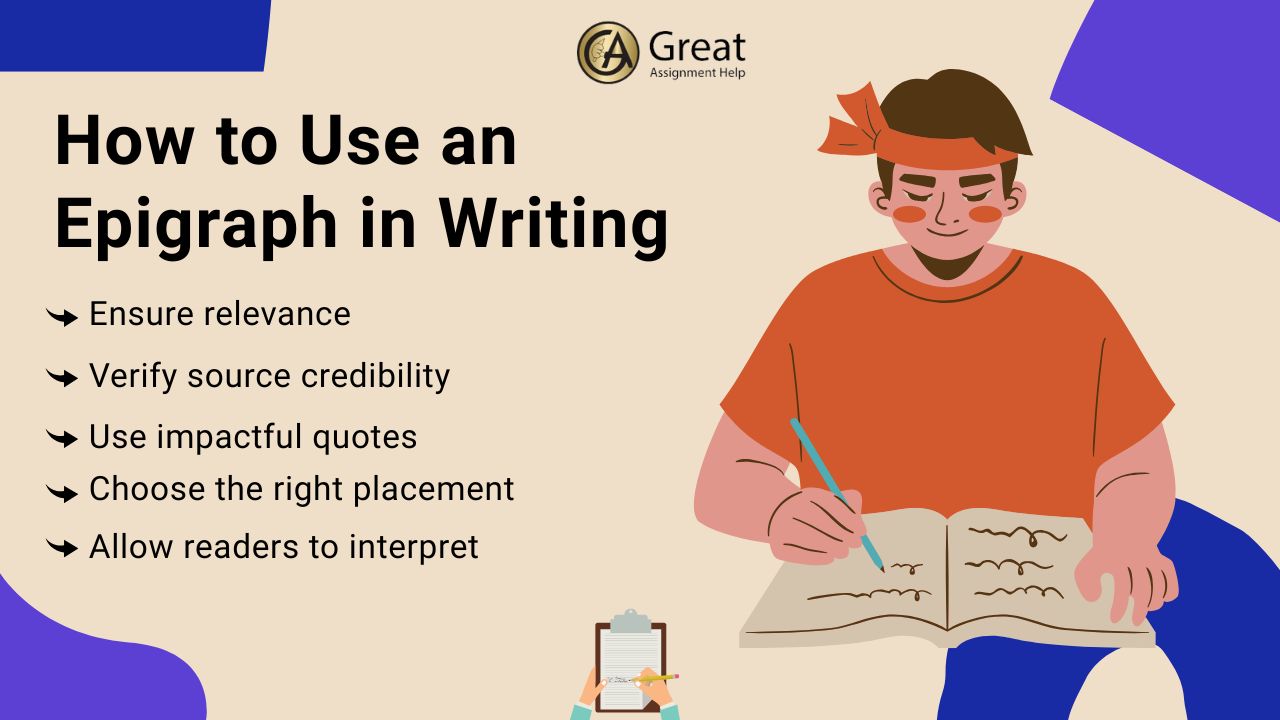An epigraph is a quote or a phrase included at the start of a writing piece to add depth to the context, convey themes, and draw readers in. You can take your writing to the next level if you know how to use epigraphs effectively.
A literary work will often convey deep meanings through fiction, non-fiction, and poetry. Mainly, to set a tone for a literary piece and invite readers into new ideas, authors will use an epigraph in their writing. An epigraph is a quote placed at the start of a literary work. Many students will be unfamiliar with the term “epigraph” and will wonder what it means. If you are also one of them, then read this blog. Here, we have shared everything about Epigraphs in literature. By reading them, you can get clarification on the concept of epigraphs in literature, along with their significance and purpose.
What is an Epigraph?
The word “epigraph” comes from the Greek term “epigraphein,” meaning “to write on.” In literature, an epigraph is an essential phrase or quote that gives context to a piece of writing. As a writer, you can use an epigraph at the beginning of a novel, poem, essay, or academic paper. Moreover, by including an epigraph, you can help your readers understand the concepts and themes of your work. You can use epigraphs in various forms of writing. It will majorly help you set the tone of your work and will offer insights into the narrative.
Uses of Epigraph
An epigraph is a powerful tool used in various literary works. The following are some written works where an epigraph was used
Classic Novels: Some classic novels have used epigraphs to enhance the reader’s experience by providing insight, context, or themes. Examples include ‘The Great Gatsby’, ‘To Kill a Mockingbird’, and ‘Frankenstein’.
Essays: Epigraphs can also be used in essays to provide context and enhance the discussion. But when using epigraphs in essays, you should consider key factors to make them effective.
Books: Epigraphs are often used in books to set the tone, provide context, or reveal the author’s intentions.
Overall, Epigraphs are the best literary devices used in many types of writing, including chapters, poetry collections, plays, short stories, memoirs, articles, and reports.
Examples of Epigraph
For your better understanding, here, we have shared some popular epigraph examples in literature.
“Lawyers, I suppose, were children once” -Harper Lee, To Kill a Mockingbird
This epigraph suggests that the current legal practitioners were once immature and innocent in their childhood, and these traits continue to influence them.
These are a few other examples of epigraph
- Sixty Million and more
- If they give you ruled paper, write the other way
- You are all a lost generation
- You are saved!
- If you can bounce high, Bounce for her too
Why is it Important to use an Epigraph in Writing?
Here, let us explore why epigraphs are important and why they are used in English literature. When writing a literary piece, you should use an epigraph for the following reasons
- Epigraphs will help you set the tone for a piece of literature. This, in turn, will help you easily grab the attention of your readers and keep them engaged.
- They will provide context and background information. So, it will be helpful for your readers to clearly understand the text.
- Epigraphs will highlight themes and create expectations. This will give your readers a sense of what is to come.
- They will connect the current work to other literary pieces and enhance the experience of your readers.
- Epigraphs will capture your readers’ attention with thought-provoking quotes and will help them deepen their understanding.
- They will add layers of meaning to the narrative to make it richer and interpretable.
How to Choose the Right Epigraph for Writing
While writing, you must use the right epigraph to set a tone and grab your readers’ attention. If you want to choose the right epigraph for writing, then follow these tips
- Choose an impactful epigraph that connects with readers and leaves a lasting impression.
- Select original quotes that offer a unique perspective, rather than using common ones.
- Use credible quotes to increase the trustworthiness of your work, especially if you are new to using epigraphs.
- Make sure the tone of the epigraph matches your work’s tone to maintain a smooth flow.
- Select an epigraph that connects well with the content of your work. This will make it easy for your readers to see the link.
How to Use an Epigraph in Writing

If you want to write an engaging paper, then make sure to use epigraphs effectively. These are the key steps you should follow to use an epigraph in writing
Ensure relevance
When you use an epigraph, you should first check its relevance. Most importantly, while choosing a quote, you should also take into account the tone, subject matter, and theme of the paper. For example, if you are writing science fiction, then you will have to choose a quote from a science-related source. This will help you maintain relevancy and give readers a hint about what is coming.
Verify source credibility
Next, you will have to check the credibility of the source of the epigraph. Remember, the quote you select should be from a well-known or famous source that your audience respects. This could be a renowned poet, author, or historical figure who adds impact to your writing.
Use impactful quotes
When choosing an epigraph, you will have to give preference to the language that evokes emotions and thoughts. Always make sure to choose quotes that are well-written and memorable. Note that the quote you include should not contain spelling or punctuation errors, and it should be accurate. This will help you leave a lasting impression on your readers and make your words more memorable.
Choose the right placement
When writing an academic paper, you should consider where to place your epigraph. In general, you can use an epigraph at the start of your paper or at the beginning of each chapter to grab attention. Also, you can experiment with different placements to see what works best. For a historical paper, you will have to use a quote or phrase at the start of each chapter to set the period.
Allow readers to interpret
For epigraphs, try to choose a quote that can be interpreted in multiple ways. Especially, when you choose a quote, consider the tone of your paper and how your readers might view it. This will allow your audience to form their opinions and engage more deeply with your work.
Tips to Format an Epigraph
The format of the epigraph you use should match the content and flow of your paper. Mainly, to help your readers understand your work more easily, you should structure and place the epigraph properly. If you have no idea how to format an epigraph, then follow these tips
Placement: When adding an epigraph, you should first decide where to place it. Typically, an epigraph will be placed before the main introduction. However, you should make sure to include the author’s name, title, and source in the same text block.
Typography: The epigraph you add should follow a unique typography, and it should look different from other text. To set your epigraph apart, you should use distinct formatting like italics and quotation marks.
Indentation: Also, to make your epigraph stand out, you should indent it from the main text and use formatting that grabs attention. If the epigraph is a paragraph or a single line, use block quotes or distinct formatting to highlight it from the rest of the text.
Consistency: If you want your paper to look neat and engaging, then maintain a consistent format throughout your paper. In case you use bold and italics in one section, then apply the same style throughout the paper to boost its visual appeal and reader engagement.
Length: There is no specific length rule for epigraphs, but shorter ones often work better. Always try to keep your epigraphs concise. Even though the epigraph is short, it should convey the key message or context.
The Bottom Line
By now, you will have gained a good understanding of epigraph. If you are still not clear about how to use epigraphs in writing, take our expert literature assignment help online. The literary experts from our team will guide you in improving your comprehension of epigraphs. Also, with their assistance, you can effectively include epigraphs in your academic paper or essays and add value to the entire work.



